Udvar-Hazy
Why are you here?
If you are an American you probably have a good reason for wanting to click on an Udvar-Hazy link because it is likely to mean something to you. If you are an average Kiwi, you probably just clicked to see what an Udvar-Hazy might be. Either way, it was a good choice because this page allows me to show off some amazing aviation stuff as Udvar-Hazy is all about planes.
Udvar-Hazy Museum
The US National Air and Space Museum of the Smithsonian Institution was established in the National Mall, Washington DC in 1946. In 2003 it opened an annex named the Steven F. Udvar-Hazy Center at Washington's Dulles International Airport in neighbouring Virginia. Both are great facilities, but this visit was with my friend Bob to explore what was on display at the Udvar-Hazy annex. We walked in the door and saw this ...

(Click on the image for a big view)
Darn! That is a lot of airplanes! Where to start! Maybe right down there - that black thing looks interesting.
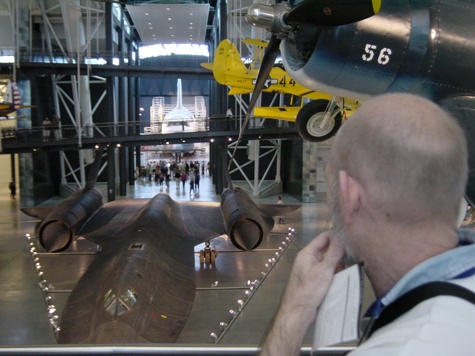
That Black Thing
That black thing turned out to be a Lockheed SR-71 Blackbird, a long-range, high altitude, Mach 3 (+) spy plane. Remember the '+' because I have a yarn about that.
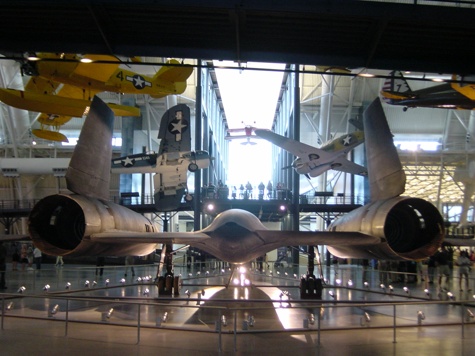
The plane was developed as a 'black project' during the 1960's by Lockheed's Skunk Works division. It entered service in 1966 and was retired by the US Air Force in 1998. NASA used it as a research platform until 1999.
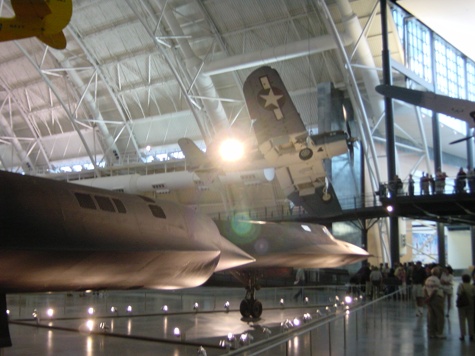
The SR-71 could operate at up to Mach 3.2 and 85,000 feet. Both of those are big numbers! In 2022 it still held its 1976 record as the fastest air-breathing manned aircraft.
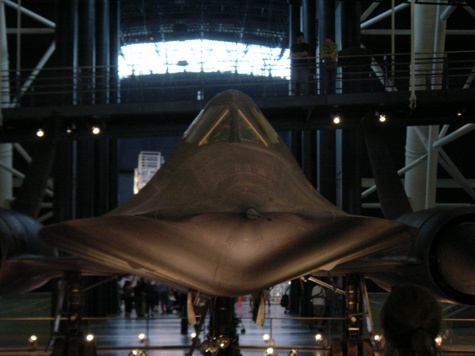
It was one of the first aircraft to be designed to have a reduced radar signature.
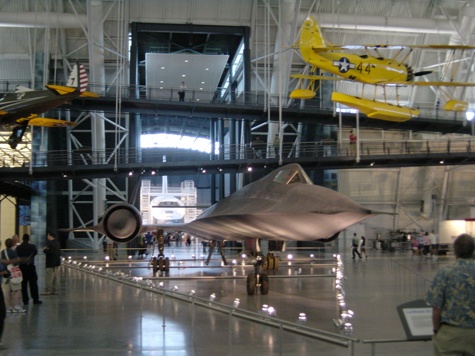
Regarding the extra '+' for its speed capability, a cobber told me about a previous job he had held as a radio technician for the NZ Airways Corporation. One day the technicians were servicing their crappy old Cossar weather Radar equipment and were fiddling around with it when they observed 'a very fast thing' coming to Christchurch airport. It landed (at a respectable pace) and turned out to be an SR-71 making a courtesy call to New Zealand airports. The pilot visited the tower and in discussion the techs mentioned how fast he had been traveling. The pilot turned pale, and said that information was classified and to please not tell anyone. Tut tut, shouldn't have been speeding! Wikipedia: SR-71 Blackbird
That Black and White Thing
Moving right along, did you spot that black and white nose back there behind the SR-71's tail?
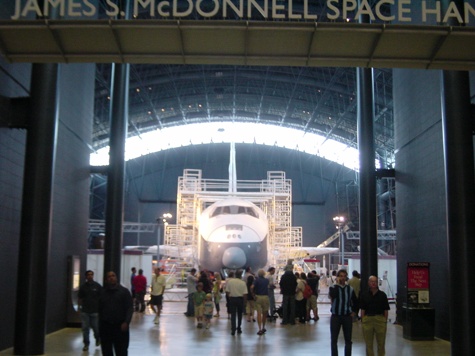
That nose belongs to a Space Shuttle - but not just any shuttle - this was the Space Shuttle Enterprise, the very first orbiter craft of the space shuttle system. It was built by Rockwell International and was rolled out in 1976.
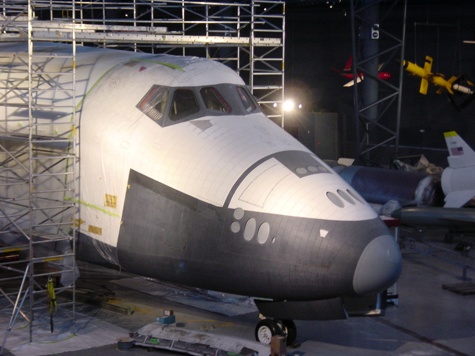
As a test aircraft it had no motors (it was taken places on, or was launched from, the back of a modified Boeing 747) and had no functional heat shield, so it was not capable of space flight. It had a total of 5 flights, all in 1977.
Research in 2022 shows that in 2012 USS Enterprise was relocated to the Intrepid Museum in New York City and was replaced at the Udvar-Hazy Center by USS Discovery.
Wikipedia: USS Enterprise
That Silver Thing
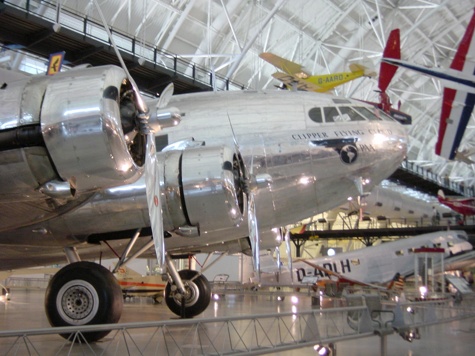
Do not be disrespectful! This aircraft lead the way in making your air travel much more comfortable than it would have been before it entered service.
This shiny silver plane is a Boeing 307 Stratoliner (or Strato-Clipper when in Pan American service). It's shape was derived from the B-17 Flying Fortress Bomber and it entered service in 1940. The 307's claim to fame is that it was the first airliner in commercial service with a pressurised cabin and supercharged engines. These features allowed it to fly at 20,000 feet, meaning it could cruise above the weather.
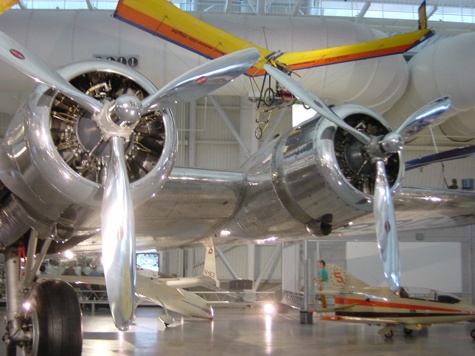
By comparison, the Douglas DC-3 was much slower and could fly up to 8,000 feet. My own memory of un-pressurized flight was on a NAC Vickers Viscount flying north from Invercargill - flapping its wings all the way to Christchurch and needing much ear-popping as we approached landing.
Wikipedia: Boeing 307 Stratoliner
Them Little Things
Say, look under the Clipper's wing - what are them-thar' little things?
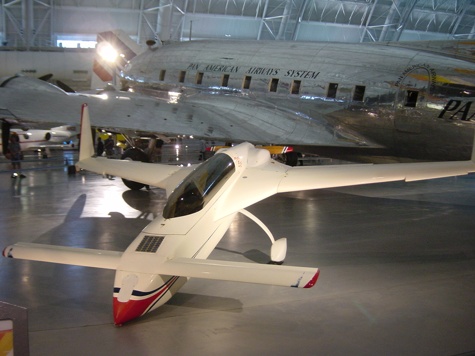
The Rutan VariEze popularised front-canard aircraft designs. Burt Rutan had once headed the flight testing program for Bede aircraft and eventually founded the Rutan Aircraft Factory. His elder brother Dick, an ex-USAF test pilot flew many of Burt's designs on record breaking flights (including round the world flights.)
Wikipedia: Rutan VariEze
Speaking oif Bede designs, right beside the Rutan aircraft is this wee plane - a Bede BD5.
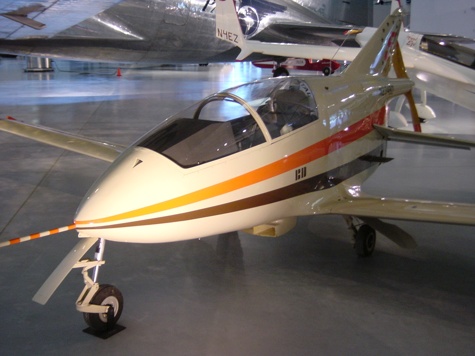
In my Private Pilot training days (I clocked up 20 hours) I drooled over the thought of owning a BD5 like this, or perhaps the jet-engined version instead. I could have kept it in my garage. This aircraft series was designed by Jim Bede in the late 1960's.
I am so pleased my dream never reached reality, as this beautiful wee plane has defeated far better pilots than I could have ever hoped to be. It still looks neat though, eh!
Wikipedia: Bede BD5
Sorting Planes by Colour
Sorting planes by colour means that when I visited Udvar-Hazy in 2004 I should have photographed a few signs as well so I would know what I am talking about. Instead, you get the 'pretty coloured planes' tour.
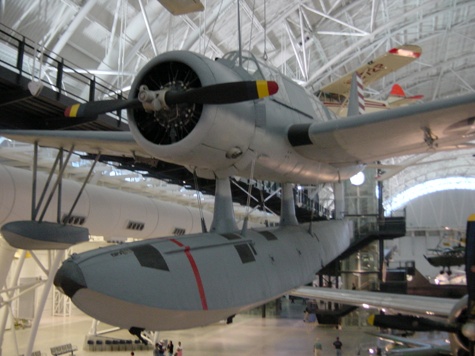
This grey'ish plane reminds me of a Harvard, so it is probably not. I think I will just stop speculating and move on to presenting yellow planes. Oh, yes. My second guess is that it is a Voight something ... wait! Thats it!
This (above) is a Vought Kingfisher, the main ship-carried observation seaplane used by the US Navy during WW II. It was catapult launched, and was recovered by landing behind the ship and running up onto a flat skid towed behind the vessel. With stacks of cunning moves a hoist wire was clipped onto the plane and it was effortlessly (!) lifted back on board. Wow.
There was also cunning in its manufacture! It was the first production type aircraft to be spot-welded (left a smooth fuselage surface with less drag) and introduced drooping ailerons which created additional lift at low speeds. Wow, wow!
Australia got their hands on 18 Kingfishers and dispatched one in support of the Australian National Antarctic Research Expedition of 1947-1948. I am so glad I remembered all that, whew.
Wikipedia: Vought Kingfisher
Now, about those yellow planes ...
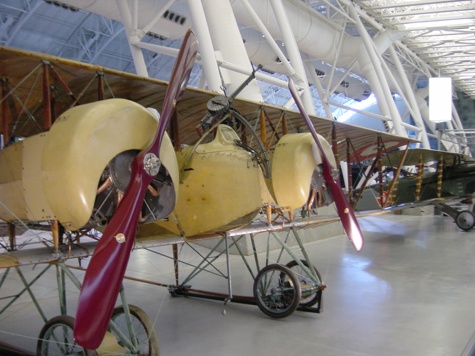
The first yellow plane is this biplane with a machine gun.
In a sudden burst of clarity I recall that it is a Caudron G-4, a twin-engined (yeah right) biplane (sigh) designed by Rene and Gaston Caudron. Oh, I didn't know ... Ahem!
The aircraft employed wing-warping for banking. Wow, that would be a first. I think the folk at Udvar-Hazy may have chosen their exhibits with precise care. This is amazing isn't it. 'tell me more' I hear you cry. Right, back into the grey cells ...
The G-4 was the world's first twin-engined aircraft to be widely used (from March 1915), country's including, Belgium, France, Finland, Italy, Portugal, UK and US.
With two engines and a large wing area the G-4 broke altitude records by flying above 19,000 feet. This is so cool.
Right, I give in. Here I advise my source ...
Wikipedia: Caudron G-4
Perhaps we might try another yellow plane ...
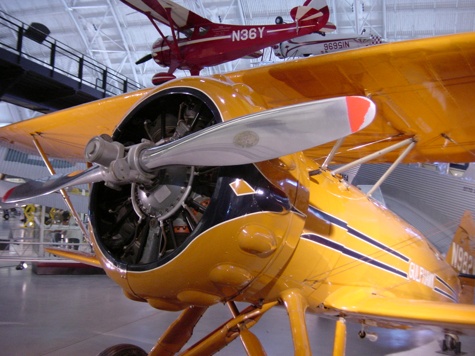
This is the second yellow plane.
Sigh, right. This airplane leads us down another amazing rabbit hole and increases my respect for Udvar-Hazy collection staff no end! So burrowing down ...
This (yellow) plane is a Curtiss F6-C4 Gulfhawk. Curtiss used many bird names for its aircraft, including various types of Hawks, hence Gulfhawk. The F6-C4 was an aircraft model used aboard the USS Lexington aircraft carrier (the Lady Lex) during the 1920's. This carrier was among the first to carry wheeled aircraft in a marine role. It was originally intended to be a battlecruiser, but the design was changed part-way through building to become one of the US Navy's first aircraft carriers.
By the end of World War 1 the Curtiss Aeroplane and Motor Company was among the biggest in the world. When they amalgamated with the Wright Brothers-originated company 'Wright Aeronautical' in 1929 to form Curtiss-Wright they became the biggest aviation company in the USA.
Curtiss-Wright produced a further evolution of the Gulfhawk. It was a parasite fighter named the Curtiss F9C Sparrowhawk which saw service aboard USS Akron and USS Macon.
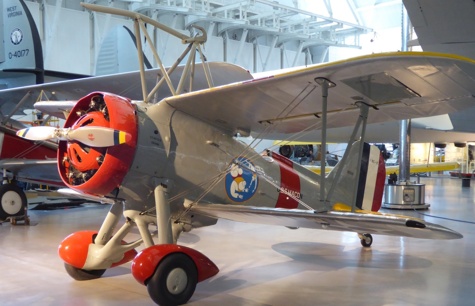
A feature that distinguishes the (grey) F9C above from the F6C is the
steel frame above the pilot's head. This was a 'capture' mechanism
that allowed the plane to fly up under an airship and 'clip on',
then to be lifted inside the airship frame where it was hosted 'like a
parasite'. USS Akron and USS Macon were US Navy airships.
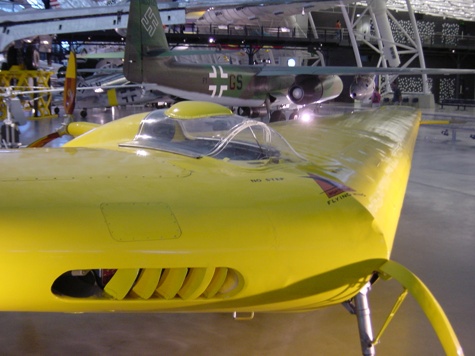
This is the third yellow plane.
It is a Northrop N1M flying wing. John Northrop had experimented with flying wing designs for over a decade when his dream became a reality with this design in July 1940. Its flying characteristics were poor, but variations in its design led to the development of B-2 Stealth bombers. Incredible!
Wikipedia: Northrop N-1M
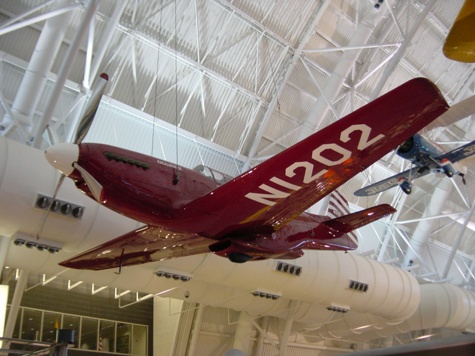
Here is my first red plane. 'Hurrah', you might shout 'A change from Curtiss aircraft!' Ah, therein lies a tale!
This red airplane (above and below) is a Mustang P-51C named 'Excalibur III'. The P-51 series of aircraft was designed by North American Aviation (NAA) to support a request from the British Purchasing Commission who asked them to build Curtiss P-40 fighters for the RAF (as Curtiss was already flat out building planes for the US war effort). The P-40 design was two years old and NAA said they could create a better design and they completed the P-51 Mustang prototype in four months.
The P-51 Mustang proved to be a winner, went through some engine changes and eventually became the single-seater fighter and fighter-bomber of choice. It wasn't as slick in a dogfight as a Spitfire, but the P-51C variant had excellent long range and high altitude capability. It was used in WW II and the Korean War, and was the last of the piston-engined fighter designs before that role was replaced by jet aircraft. It was fast enough that it could chase and attack German V2 long-range bombs.
With the end of the wars many P-51 aircraft entered the civilian market, being displayed at air shows and used as air racing aircraft. The amazing Udvar-Hazy collection staff have managed to get their hands on the privately owned 'Excalibur III'. Originally owned by film stunt pilot Paul Mantz, he won air races in 1946 and 1947, then placing second (1948) and third (1949). He also set a US coast-to-coast speed record in 1947.
Mantz sold the plane to Maureen O'Hara'sfuture husband Charles F Blair Jr. who renamed it Excaliber III, then set his own amazing records. In 1951 he flew 5,550 km direct from New York to London in 7 hrs 48 mins, then later that year flew5,040 km from Norway to Fairbanks, Alaska via the North Pole using sun-sight navigation.
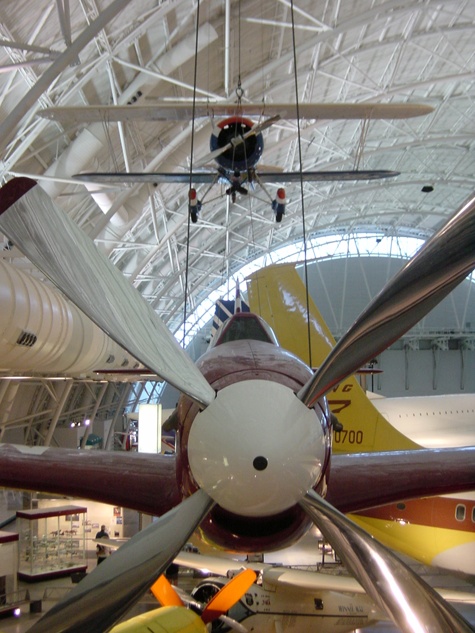
And here is the propeller-end of this great game-changing P-51C Mustang aircraft. What a story it recalls!
Wikipedia: Maureen O'Hara
Wikipedia: NAA P-51 Mustang
Enola Gay
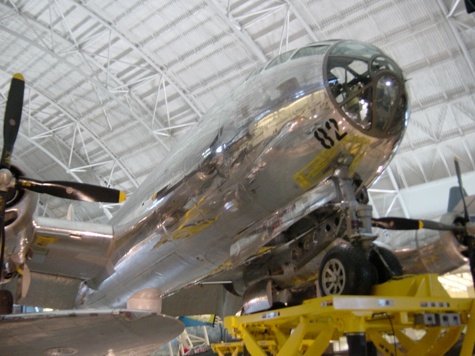
The Enola Gay gained its name from the pilot's mother, Enola Gay Tibbets, and is a Boeing B-29 Super-fortress bomber. The Enola Gay gained its place in history by dropping an atomic bomb, code-named 'Little Boy' on Hiroshima, Japan in August 1945.
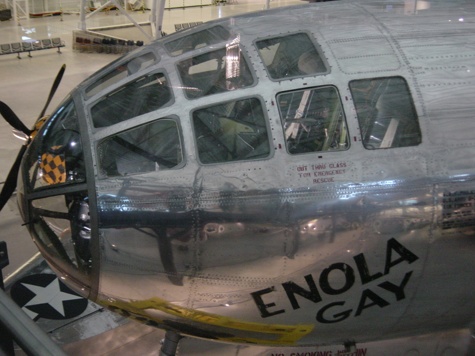
Wikipedia: Enola Gay
Focke-Wulf Fw 190
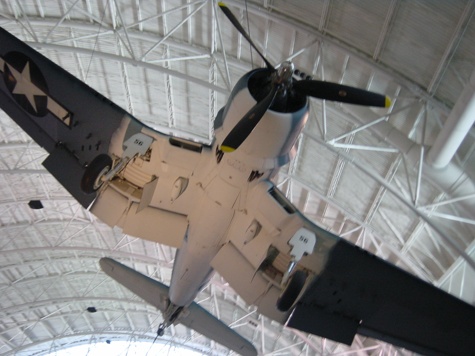
A German single-seater fighter aircraft that out-performed its counterpart, the Messerschmitt Bf 109. The Fw-190 performed well in such roles as day fighter, fighter-bomber and ground-attack fighter. Its German pilots rated it as one of the best fighter planes of World War II.
Wikipedia: Focke-Wulf Fw-190
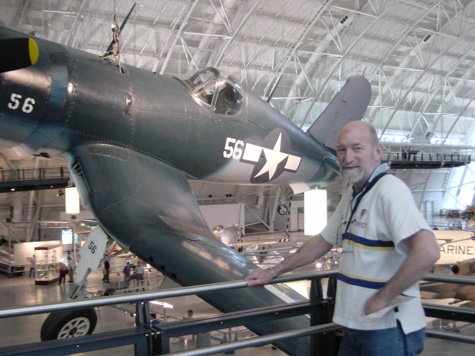
As we consider our 'best of the best' choices, Bob is happy to be photographed beside the Focke-Wolf.
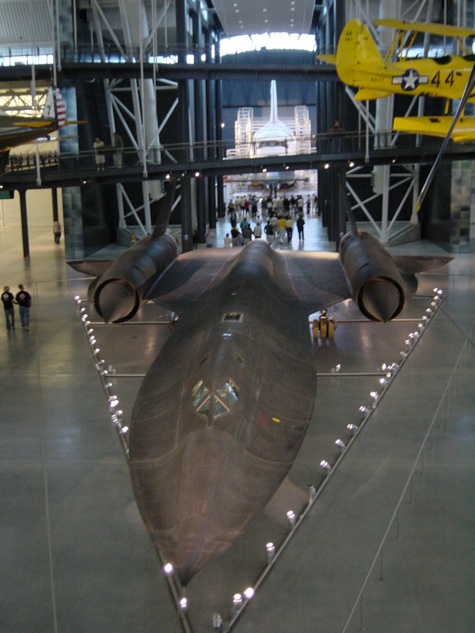
And Rex thinks ' The Black Thing' deserves its place at front and center (but still dreams of a BD5 in his garage).
Thanks for sharing our explore at the Udvar-Hazy Center.
Here are links to:Wikipedia: Steven F. Udvar-Hazy;
Wikipedia: The Udvar-Hazy Center; and
Wikipedia: National Air and Space Museum